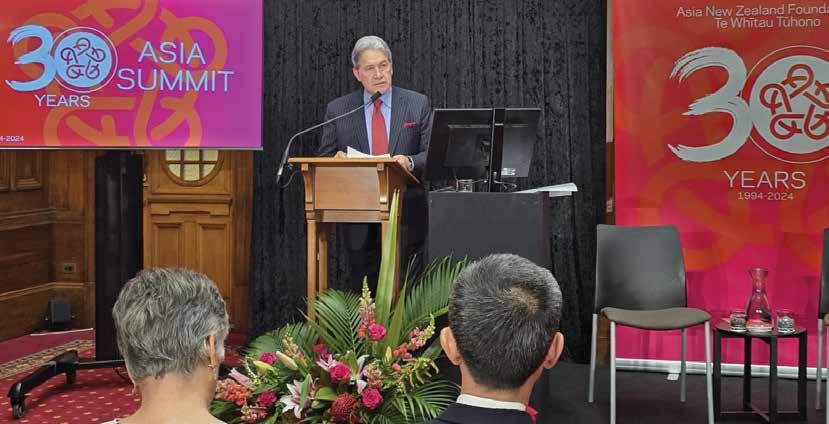
16 minute read
Fostering better understanding
Winston Peters outlines a crucial need in advancing New Zealand’s relationship with Asia.
New Zealand is an Indo-Pacific country. This is its identity, and this is where its future lies. With every forecast about Asia’s trajectory, this becomes clearer and clearer. As New Zealand navigates its own pathway forward, there is a pressing need to understand Asia. If it does not, its relationships will inevitably be characterised by misconceptions, bias and miscalculation. Given the importance of Asia to New Zealand’s future prosperity, a better understanding of the vast range of cultures, languages and peoples of the region is now essential. In this situation the Asia New Zealand Foundation has played a very important role.
A lot has happened over the past 30 years — in New Zealand, in Asia and indeed in New Zealand’s engagement with Asia. It is, of course, difficult to talk about Asia in general terms. The region has 23 countries, hundreds of languages and a vast swathe of peoples and cultures and political systems. This is to say nothing of the vast distances in Asia. Indeed, it is closer from London to Moscow than Auckland to Jakarta, and yet we tend to think of Indonesia as our back yard. We tend to zone in on one country, or one issue.
Our understanding needs to be more nuanced than this — something the Asia New Zealand Foundation knows well and is in fact its core mission. We can, however, look at some trends, as we think about New Zealand’s relationship with Asia over the past 30 years. In 1994, for example, Asia’s population was over three billion people. The region accounted for one-quarter of the world’s GDP, and economic growth was underway in many countries. The region had experienced years of peace and stability, albeit with some notable exceptions. Many parts of the region were at the start of a long, although sometimes uneven, path of rising urbanisation, productivity and incomes.
In New Zealand, our population had just tipped over three million. Asian countries had become important trading partners — this was twenty years after Britain joined the European Economic Community and forced us to look beyond our traditional trading partners. We had adapted by looking closer to home. Thirty-five per cent of New Zealand’s exports went to Asia, with Japan accounting for close to half of this. Remarkably, at that time China took just 2 per cent of our exports, compared to 20 per cent today.
Many New Zealanders had come to realise the importance of Asia to our future prosperity. Along with this came a recognition that we needed to better understand the vast range of cultures, languages and peoples of the region. This would be a shift for us. Just 3 per cent of New Zealanders at the time identified as being of Asian origin — compared to 17 per cent today. We had the beginnings of some cultural and culinary influences, with tourist and student exchanges gaining pace. Under the Colombo Plan, we had welcomed many Asian students to New Zealand. But for the most part, these cultural influences were not mainstream or well-understood at the time. It was in this context that the Asia New Zealand Foundation was born and began its important work.
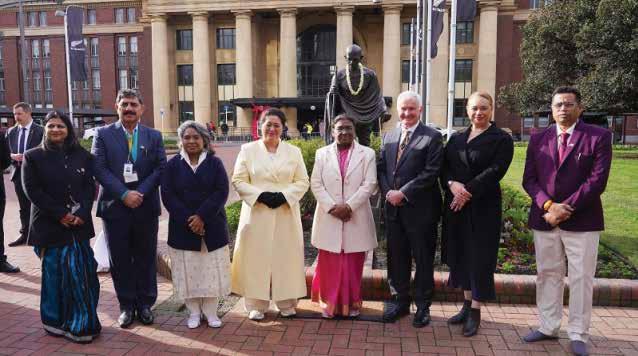
What has changed in Asia? Even those who were aficionados back in 1994 might have been surprised at just how important Asia would become to New Zealand. The Asian financial crisis in 1997 was devastating to the region. It was an unsettled and unpredictable time. But the region has recovered, and in fact boomed. The figures are certainly impressive. More than one billion people have been lifted out of poverty in Asia since 1990. Asia now comprises over 40 per cent of the world’s GDP. In the next quarter-century, this is forecast to reach 50 per cent. It is important for us to remember that there has not been just one linear trajectory in the region. Each country has had its own path, and these paths can have different twists and turns over time.
Extraordinary growth
China’s growth story is, of course, well-known, but the statistics remain extraordinary. Today, China stands as the world’s secondlargest economy worth nearly US$18 trillion in 2023, soaring a staggering 4000 per cent since the 1990s. This is not, however, just a China story. There has been astonishing success in other countries, too. India overtook China to become the most populous country in the world in 2023, and with 900 million registered voters it is also the world’s largest democracy. In 2024 India’s economy was the fastest growing in the G20, and it is expected to overtake Germany and Japan to become the world’s third largest economy in the next few years.
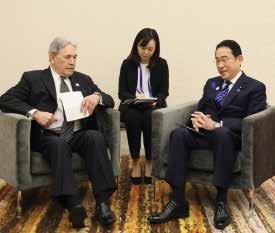
India’s advances in science, technology, education and space are inspiring to many countries around the world. In short, India has become a significant global actor playing a key role in securing a stable and prosperous region. Japan itself continues to be an economic powerhouse. We must also recognise that ASEAN’s growth, after starting down the path of economic integration, has been remarkable. If ASEAN today were one economy, it would be New Zealand’s fourth largest trading partner. Its countries are growing at an impressive clip — more than 5 per cent year in, year out. The total GDP of ASEAN reached nearly US$4 trillion last year, positioning it as the fifth largest economy in the world. Projections indicate that ASEAN’s GDP is poised to reach an estimated US$4.5 trillion by the year 2030. This will propel ASEAN to become the world’s fourth largest economy by 2040.
Much of Asia’s economic growth has been built on trade and manufacturing. But the region is now also central across many facets of the modern economy — from finance and capital, to people and to innovation. To take just two examples, Asia’s services trade is growing 1.7 times faster than that of the rest of the world. And by 2030, Asia’s fintech revenues are expected to be larger even than that of North America.
We know economic growth does not happen in a vacuum. It is regional security that has provided the foundation for the significant rise in living standards we have witnessed across Asia. In this time of global upheaval and challenges to the rules-based order, the role of regional security in our collective economic security is undeniable. In South-east Asia, ASEAN centrality is playing a pivotal role. ASEAN has led the way in bringing the region together in peaceful dialogue. This includes initiatives like the Regional Forum we attended in July or the East Asia Summit last October.
Security challenges
Notwithstanding the various peaceful offramps that exist, Asia has had, and continues to have, security challenges. The liberal rules-based order is under strain. As China’s power and influence have increased, so, too, have the areas of difference that we have had to navigate. We are seeing a rising and more active India. And we should not forget that Russia considers itself an Indo-Pacific power also.
Added to this are hemispheric wild cards: North Korea; other nuclear powers; arms build-up; and alliance and proxy relationships. We also have population trends that will have not just economic but also geostrategic consequences. Also, fierce competition for resources: protein and commodities like rare metals. Finally, environmental challenges, which are an existential threat for many countries in the region, are exacerbating all these factors.
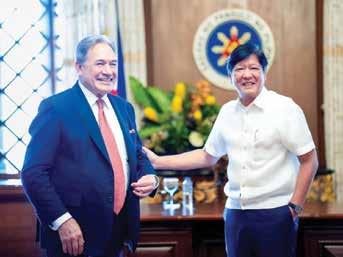
For New Zealand, the message is clear: we need to continue to understand and engage with Asia. The Coalition government, via the Foreign Policy Reset, is focused on building and advancing relationships in a way that responds more actively to the region’s opportunities and risks. The work of the Asia New Zealand Foundation remains as relevant today as it was 30 years ago. Understanding Asia starts here at home. The past 30 years has seen a boom, and our ethnic communities have grown significantly.
While there is still some way to go, we have started to see Asian New Zealanders in leadership roles — from members of Parliament to business leaders, sports people and entertainers. Along with this has come a richness of culture and language. Kiwis have enjoyed new festivities and embraced an array of Asian cuisine, at home and at restaurants — something rarely available 30 years ago. The top 25 languages spoken in New Zealand include many Asian languages, such as Mandarin, with nearly 100,000 speakers, as well as Hindi with almost 70,000, Cantonese, Tagalog, Punjabi, Korean, Japanese, Gujarati and Tamil. We celebrate Diwali, Lunar New Year and Eid festivals that showcase cultural traditions to New Zealanders.
In 2023, 54,000 students from Asian countries came to study in New Zealand education institutions. During 2024 we welcomed over 700,000 international visitors from Asia — nearly double that of the previous year — and we are looking forward to seeing this growth continue over the coming years as the pandemic fall-out recedes. Over the last 70 years, we have provided scholarships and training to 21 countries from the Asian region under our International Development Cooperation programme. This remains a foundation of our enduring peopleto-people connections.
Changed attitudes
Thanks to the Asia New Zealand Foundation, we have some tangible evidence of how New Zealanders’ attitudes toward Asia have changed over time. The first Perceptions of Asia survey was conducted in 1997 and showed that New Zealanders saw Asia as something largely external. Today, however, over half of New Zealanders feel a connection to Asia in their daily lives, with more than a third regularly enjoying Asia-related entertainment.
Over the past decade, public awareness and engagement with Asia has grown significantly. In 2013, one-third of New Zealanders said they felt knowledgeable about Asia. That number has now risen to an all-time high, with nearly 60 per cent saying they possess at least a fair amount of understanding about the region. This is wonderful and thanks in no small part to the work of the foundation. We hope we will see this familiarity grow further in the coming years.
Alongside these developments in New Zealand, we have been engaging both with Asia and also in Asia. Today you can fly direct from Auckland and Christchurch to fourteen destinations across Asia, connecting New Zealand to the region and providing opportunities for New Zealanders to interact with and learn about Asia. Kiwis have been broadening their traditional ‘OE’ and heading to Asia. As just one example, 3300 New Zealanders have travelled to Japan under the Japan Exchange and Teaching, or ‘JET’, programme since its inception, teaching English in Japan. Programmes such as the Prime Minister’s Scholarships for Asia have seen thousands of young New Zealanders study at Asian institutions and return with meaningful skills and experience. The Asia New Zealand Foundation has also contributed to this through the internships, grants and residencies it offers throughout Asia.
It is important to highlight that seven of our top ten export destinations are Asian economies. Exports to China amounted to $20 billion last year; Japan more than $4 billion. Korea, Singapore, Taiwan, Malaysia and Indonesia round out the list of our top export destinations in Asia. This has been supported by the network of free trade agreements we have negotiated to support our commercial partnerships over the past twenty years. It is notable that our second oldest free trade agreement is with Singapore — second only to Australia.
CPTPP origins
The origins of the Comprehensive and Progressive Agreement for Trans-Pacific Partnership, one of our most significant trade agreements, also finds its origins in our relationships with Asia. Its precursor, the P4 agreement with Singapore, Brunei and Chile in 2006, provided the foundation stone for what would become CPTPP. The agreement is itself a high watermark agreement that includes other economies from the region such as Japan, Malaysia and Vietnam, and we continue to encourage others who can meet the agreement’s high standards to seek to join in the future. All in all, 95 per cent of our trade with Asia takes place under a trade agreement. New Zealand has also invested in regional institutions. This architecture provides space for dialogue and the exchange of ideas on key issues impacting us. We were the second country to become an ASEAN dialogue partner, and we will celebrate the 50th anniversary of this in 2025. In that time New Zealand has been a trusted partner to ASEAN and its member states.
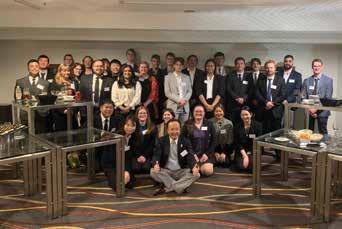

We know that by contributing to ASEAN’s success, and the success of ASEAN-led councils like the East Asia Summit, we contribute to our own success and to that of the region. In 1994, New Zealand was a member of one regional body — APEC, which was founded just five years earlier. This platform gives us a venue to influence regional economic policy together with members that today make up two-thirds of global economic growth and take 80 per cent of New Zealand’s exports.
Just over ten years later, in 2005, our delegation was proud to take part in the inaugural East Asia Summit in Kuala Lumpur attended by then Prime Minister Helen Clark. We had put intensive effort into laying the groundwork for the shape of the grouping and New Zealand’s participation. Our membership as a founding partner made clear to all that New Zealand was part of the region and had a role to play in regional decisions.
The EAS is now the premier forum for strategic dialogue and regional co-operation. New Zealand is showing up today, as we did then, because we want to support peace and stability in the region in tangible ways. Recent years have seen the emergence of new plurilateral and ‘minilateral’ architecture alongside established multilateral architecture. New Zealand supports new groupings that advance and defend our interests and capabilities, and we see no reason why these cannot coexist as long as they are constructive, advanced in an open and transparent way and are respectful of ASEAN centrality.
Korea concerns
We have championed a stable, peaceful and nuclear-free Korean peninsula. In the current climate, it is not possible to visit North Korea. But in the past, we have. During a 2007 visit, we met with political leaders and advocated in favour of multi-party peace talks. To this day, New Zealand Defence Force assets and personnel are deployed in Korea to maintain the armistice. The Defence Force also has a separate deployment to monitor and deter North Korea’s evasion of UN sanctions.
In 2006, we received a request from East Timor, seeking assistance to restore stability and freedom of movement. We responded swiftly, deploying police and military troops. In a testament to our security co-operation in the region, Singaporean personnel were integrated seamlessly into a New Zealand battalion.
New Zealand has a long-standing development programme in Asia. It is our largest programme outside the Pacific and is growing. It goes beyond training and scholarships to respond to the priorities of our ASEAN partners, as well as humanitarian assistance. In September, for example, we contributed humanitarian assistance in response to the devastating impacts of Typhoon Yagi in Vietnam and Myanmar and to extreme flooding in Bangladesh.
It is also worth noting that, for the past 30 years, New Zealand has advanced its policy towards Asia in a bipartisan way wherever possible. This has ensured successive governments can follow through on policy commitments and is one of our greatest strengths.
It is instructive to think about how far we have come in the past 30 years. But it is also clear that we need to do more. The world today is disordered and becoming more dangerous. As we said to the NZIIA in May, ‘the challenges we face are stark, the worst that anyone today working in politics or foreign affairs can remember’.
As MFAT’s own strategic assessment has identified, one of the drivers for this has been a shift from rules to power: the post-Cold War ‘unipolar’ moment is over. The multipolar world is here to stay, and states, large, middle and small, are all jostling to advance their interests. Added to this is the fact that global problems — whether health, environmental, demographic or migratory — present global risks, but at the same time require state-to-state co-operation to resolve.
We offer this simply to point out that we are living in a time where relationships, norms and rules — many of which have enabled the rise of countries in Asia, including those which seek to challenge those same rules — are changing at the very time when we need to maximise global co-operation. This is at the heart of what is happening in Asia, as well as around the world more broadly. This is why the government decided early in 2024 on a Foreign Policy Reset. A fundamental driver was that our foreign policy needs to reflect and respond to the challenging strategic context we find ourselves in.
Increased focus
We need to act now to bring more energy, ambition and engagement to our relationships. Under the Foreign Policy Reset, we have been explicit: we will be increasing the focus on and resources applied to South-east Asia, South Asia, especially India, and North Asia. This is what will have a major impact on our security and prosperity. We are already delivering on this. Since taking office we have travelled to 31 countries. Prime Minister Christopher Luxon and other international-facing ministers have also been incredibly active.
We have taken forward concrete initiatives to demonstrate the importance and future trajectory of our partnerships. This ranges from co-operation with Japan on a hospital in Kiribati to a customs co-operation arrangement with India to advancing toward comprehensive strategic partnerships with ASEAN and South Korea.
New Zealand is an Indo-Pacific country. This is our identity, and we know this is where our future lies. With every forecast about Asia’s trajectory, this becomes clearer and clearer. It was this realisation that led to the Asia New Zealand Foundation’s birth 30 years ago. A lot has changed since then. Asia has evolved, and New Zealand’s relationship with Asian countries has evolved too, in some ways beyond recognition.
As we navigate our own pathway forward, we need to understand Asia. If we do not, our relationships will be characterised by misconceptions, bias and miscalculation. So, our work has really only just begun. New Zealand’s security and prosperity depends on us continuing it.
Rt Hon Winston Peters MP is New Zealand’s deputy prime minister and minister of foreign affairs. This article is the edited text of a speech he gave to the Asia New Zealand Foundation’s 30th anniversary ‘Asia Summit’ in Parliament’s Legislative Council Chamber on 15 October 2024.






